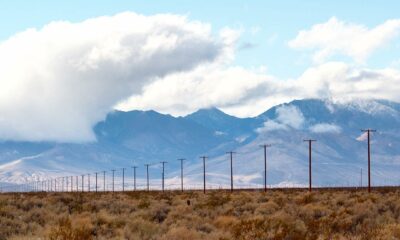Executive
Lowering Energy Costs in America
How to increase energy supply rapidly, to lower costs in the States whose residents can least afford to pay the high prices.

Upon returning to the White House, President Trump immediately outlined a vision for a new “Golden Age of America,” unabashedly powered by American innovation and American energy dominance. If we hope to restore manufacturing, win the global AI race, jump-start the auto industry, and increase our housing supply, we need to increase our energy supply – and fast.
The bitter price of bad energy policy
Today, many communities are quite literally paying the price for poor policy choices. For example, New Jerseyans are bracing for an upcoming 20% hike in electricity rates this summer, while residents of Wyoming, Idaho, and Utah consistently pay a fraction of the price for power.
But what led to this stark dichotomy in energy affordability in the first place? There are some clear trends in the data that help explain why Americans in New England are often charged nearly twice as much as Mountain West states for their electricity.
To help make sense of America’s energy landscape, the American Legislative Exchange Council (ALEC) just published its annual energy affordability rankings across the states, studying the practical effects of state legislation on electricity prices.
Setting aside the geographic outliers of Alaska and Hawaii, the 10 states with the most expensive average electricity prices—California, Massachusetts, Connecticut, New Hampshire, Rhode Island, New York, Maine, Vermont, New Jersey, and Maryland—have all enacted impractical clean energy mandates, all subscribe to the Regional Greenhouse Gas Initiative or a comparable cap-and-trade regime, and all have state-mandated policies subsidizing renewables.
How ten States made energy affordable
Meanwhile, the best 10 states for energy affordability—Wyoming, North Dakota, Idaho, Utah, Nebraska, Washington, Oregon, Iowa, North Carolina, and West Virginia—chose a different path. These states have largely implemented more market-driven policies, resulting in a diverse and competitive mix of generation sources that boosts reliability and consistency in rates.
Of the more affordable states, only Oregon partakes in a cap-and-trade program, five states declined to impose renewable portfolio standards on their electricity production, and three states have friendlier policies on net metering that avoid burdening ratepayers.
In Idaho, just over half of the state’s electricity is derived from conventional hydroelectric energy, a quarter comes from natural gas, and the final quarter results from a combination of wind, solar, and wood. The Gem State plays to its regional strengths and avoids the strict government policies that artificially increase the cost of generation or subject residents to burdensome carbon taxes.
The new ALEC research confirms what many policymakers and industry leaders have warned for years: Too much government meddling in the energy market leads to higher energy costs for all. State legislators should implement policies that avoid preferencing one favored energy source, such as offshore wind, and instead pursue the energy mix demanded by residents and ratepayers in a competitive marketplace.
Proposed reforms
A bipartisan group of governors from states such as West Virginia, Oklahoma, and Pennsylvania is also exploring how laws like the National Environmental Policy Act (NEPA) might be reformed to accelerate the permitting process, streamline infrastructure development, and increase resiliency and consistency across the grid. This will help speed the development of new and much-needed projects using a range of generation sources, from solar and wind to natural gas, and even nuclear.
And finally, legislators in states like New Jersey should reconsider whether participation in the Regional Greenhouse Gas Initiative, renewable portfolio standards, and net metering are still in the best interest of their constituents.
States need to act now with new production and expanded grid capacity to support the coming electricity demand. Unfortunately, many states have pursued misguided progressive policies that have directly contributed to higher energy prices for years. These policies have left those states with a fragile energy infrastructure that fails to meet the everyday needs of ratepayers.
How reform can work
By incorporating proven policy solutions in a competitive energy marketplace, state leaders can unlock America’s latent energy and natural resource potential, deliver abundant power to families cooling their homes or commuting to work, and equip our businesses to succeed in our evolving economy. This approach will foster energy affordability and reliability for all Americans.
The erosion of our energy infrastructure by progressive activism was completely avoidable. It must be corrected quickly for America to live up to the promise of a Golden Age and maintain its position as the world’s most prosperous and productive economy.
This article was originally published by RealClearEnergy and made available via RealClearWire.
Jake Morabito is senior director of the Energy, Environment, and Agriculture Task Force at the American Legislative Exchange Council (ALEC).
-

 Civilization3 days ago
Civilization3 days agoDC Pipe Bomb Arrest Raises Questions About Christopher’s Wray’s FBI
-

 Civilization4 days ago
Civilization4 days agoThe Legal Logic Behind U.S. Operations Against Narco-Terrorist Networks
-

 Executive4 days ago
Executive4 days agoNewsom’s ‘National Model’ for Homeless Wracked by Fraud
-

 Executive3 days ago
Executive3 days agoWhen You’re in a Hole, Stop Digging
-

 Education3 days ago
Education3 days agoWaste of the Day: Taxpayers Subsidize Football Coach Severance
-

 Executive2 days ago
Executive2 days agoWaste of the Day: Obamacare Failed Test, Approved Fraudulent Subsidies
-

 Civilization2 days ago
Civilization2 days agoPence Calls on Trump To Fire RFK Jr Over Abortion Drug
-

 Executive4 days ago
Executive4 days agoWaste of the Day: Feds Pay Nonprofits That Sue the Government














